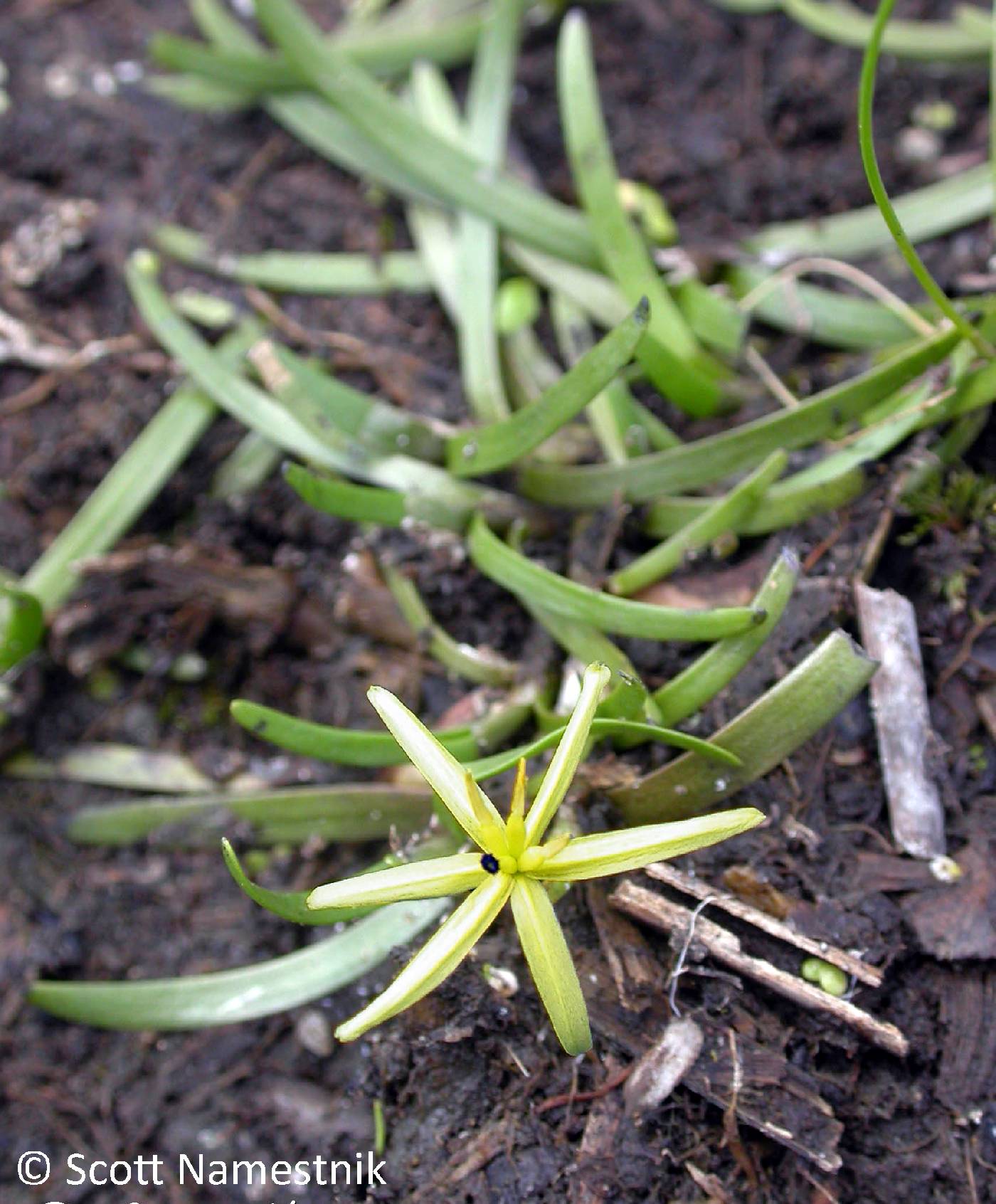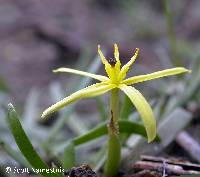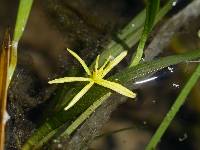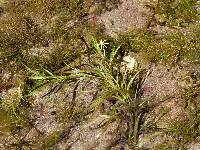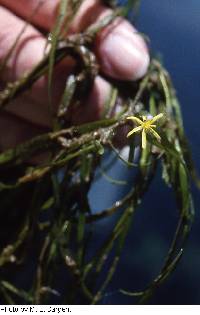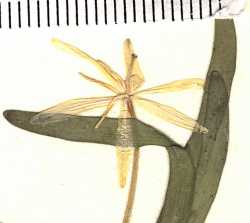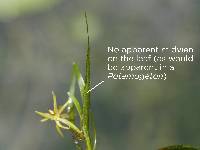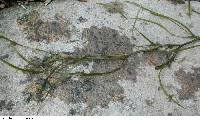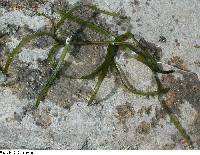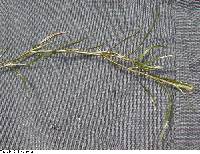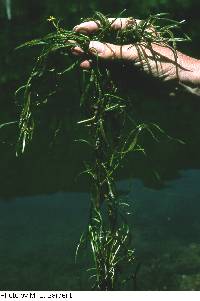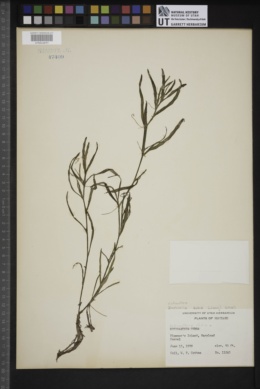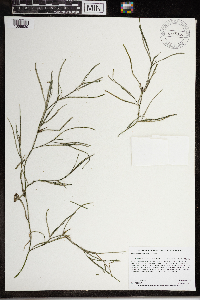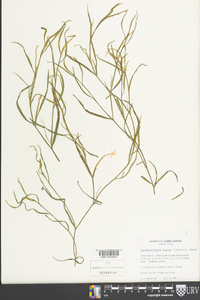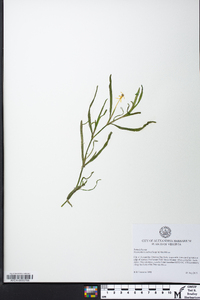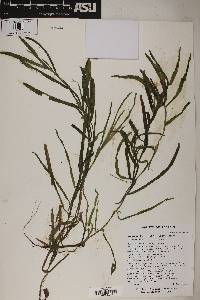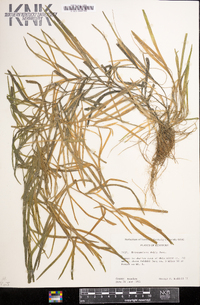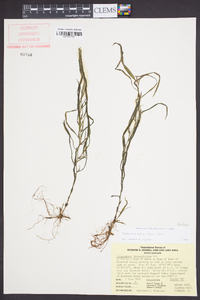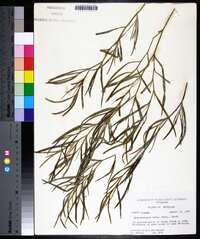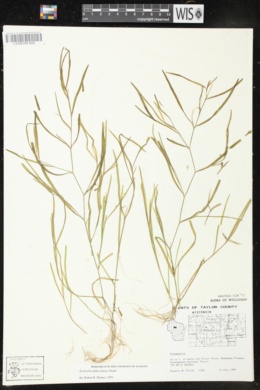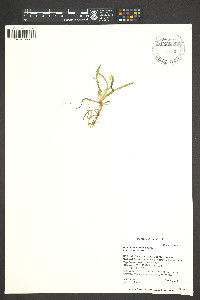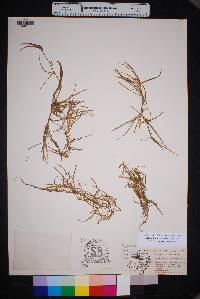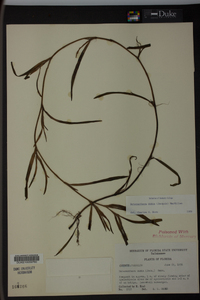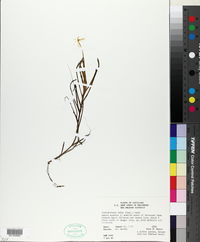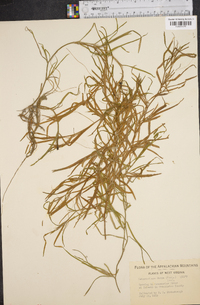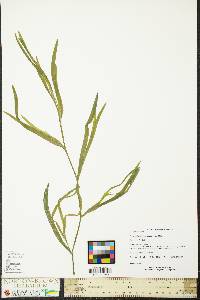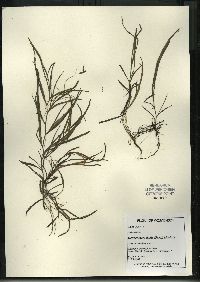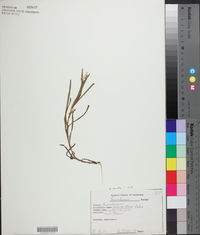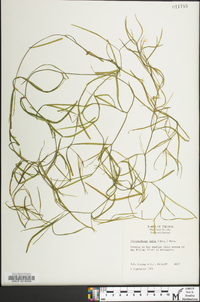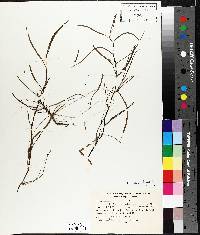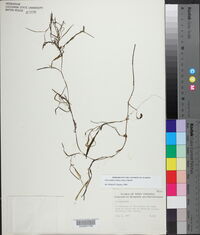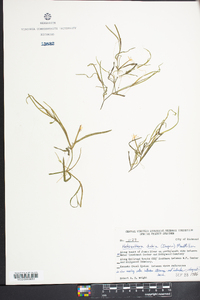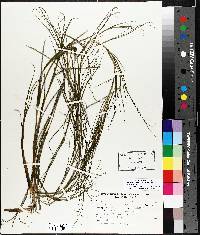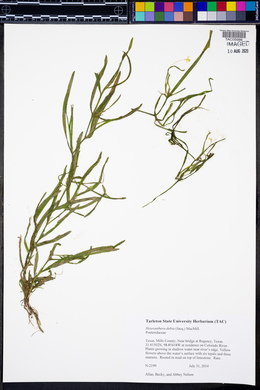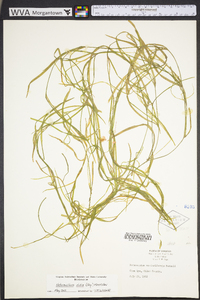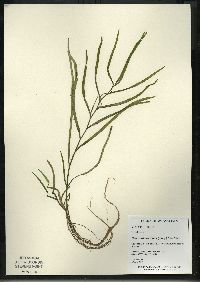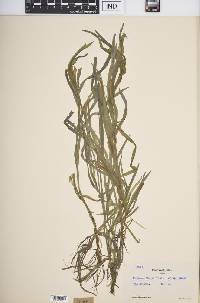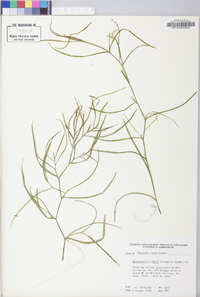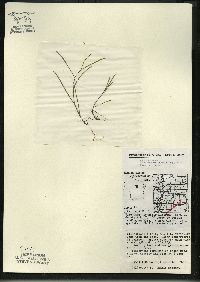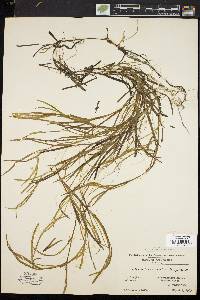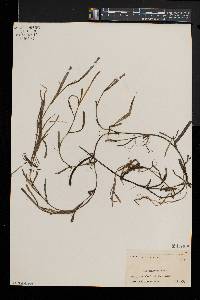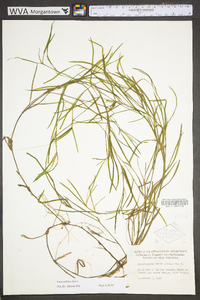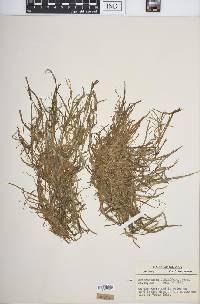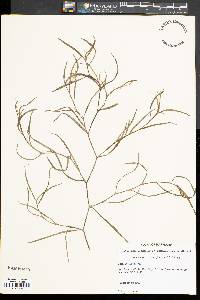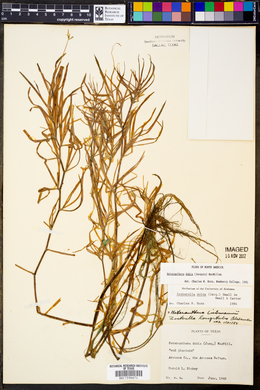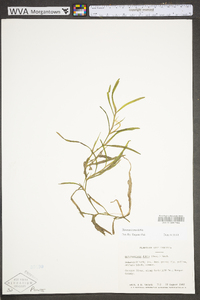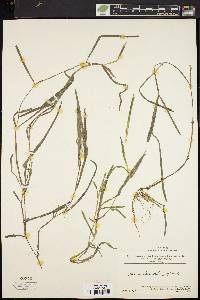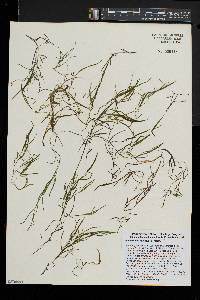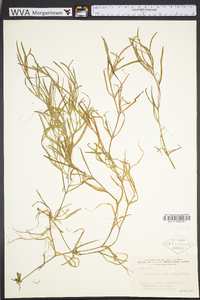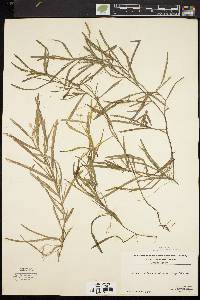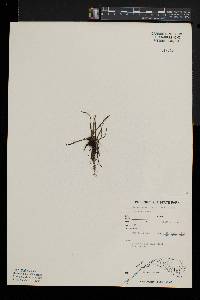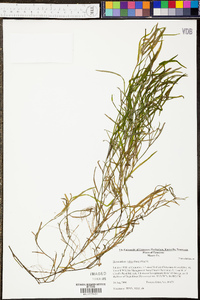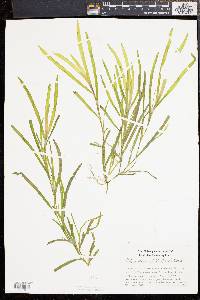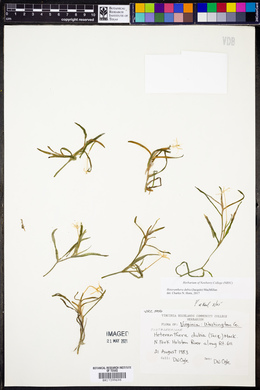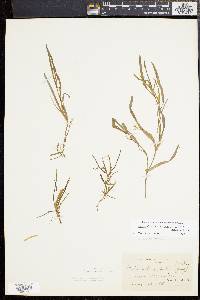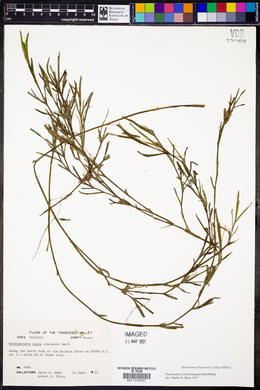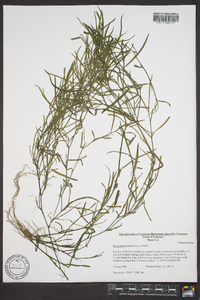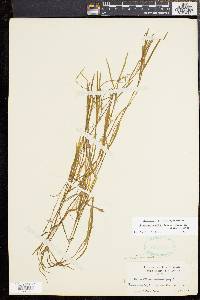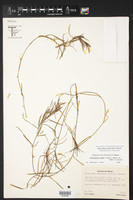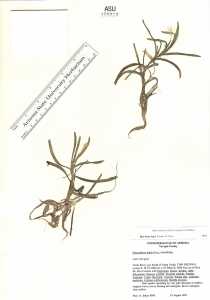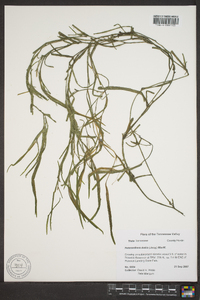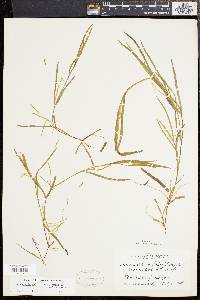Heteranthera dubia
|
|
|
|
Family: Pontederiaceae
Grass-Leaf Mud-Plantain
[Heteranthera graminea (Michx.) Vahl, moreHeteranthera liebmannii (Buch. ex Magnus) Shinners, Potamogeton liebmannii , Schollera graminea (Michx.) Raf., Schollera graminifolia Willd., Zosterella dubia (Jacq.) Small, Zosterella longituba Alexander] |
Plants perennial. Vegetative stems submersed and growing to surface, or emersed and contracted, procumbent. Flowering stems less than 5 mm, no visible distal internode. Sessile leaves alternate or appearing opposite at nodes with inflorescences, blade linear, thin; submersed leaves 3-10 cm × 1-5 mm, emersed leaves 2-4 cm × 1-3 mm. Petiolate leaves and stipules not produced. Inflorescences 1-flowered; spathes 12-45 mm, glabrous; peduncle absent. Flowers opening within 2 hours after dawn, wilting by dusk; perianth yellow, salverform, tube 1.5-11 cm, limb lobes equal, of uniform color, linear, 4-11 mm; stamens equal, 2-10 mm; filaments centrally inflated, glabrous; anthers coiling after anthesis, by early afternoon; style glabrous or scarcely pubescent. Seeds 7-30, 12-22-winged, 1-1.6 × 0.5-1.3 mm. 2n = 30. Flowering Apr--Nov. Streams, rivers, ponds, lakes; 0--1500 m; B.C., Man., N.B., Ont., Que.; Ala., Ariz., Ark., Calif., Conn., Del., D.C., Fla., Ill., Ind., Iowa, Kans., Ky., La., Md., Mass., Mich., Minn., Mo., Nebr., N.H., N.J., N.Y., N.C., N.Dak., Ohio, Okla., Oreg., Pa., S.Dak., Tenn., Tex., Vt., Va., Wash., W.Va., Wis.; Mexico; West Indies (Cuba). Extensive vegetative variation has been noted in the leaf morphology of Heteranthera dubia (C. N. Horn 1983). Plants in ponds and lakes tend to have longer, narrower leaves than plants from streams and rivers with a unidirectional current. Laboratory growth experiments revealed at least some genetic component to the differences (C. N. Horn 1981). Plants are most extensive in their growth in alkaline waters (J. B. Moyle 1945), and, if plants are in a great enough density, they can cause an increase in water pH (E. B. Hollingsworth 1966). Growth in some lakes, streams, and canals has resulted in the species being considered a weed (E. B. Hollingsworth 1966). Some authors (J. K. Small and J. J. Carter 1913; E. J. Alexander 1937) have transferred this species to the segregate genus Zosterella, based on the equal stamens (vs. nonequal in Heteranthera s.s.) and narrow, erect anthers (vs. broad and versatile). Small and Carter first described Zosterella citing only the above differences. Alexander later reported several more distinguishing characteristics: anthers coiling after anthesis, spathes sessile, and seeds relatively few. Recent molecular work by S. W. Graham et al. (1998) using chloroplast DNA suggests that Heteranthera dubia is clearly nested within the genus Heteranthera and is most closely related to H. seubertiana Solms, a tropical species. Variation in perianth size has been a basis for separate recognition of Heteranthera liebmannii, or its equivalent, Zosterella longituba (E. J. Alexander 1937; D. S. Correll and H. B. Correll 1972). Alexander used differences in the lengths of perianth tube and lobes, and length of the perianth tube relative to that of the spathe to distinguish that segregate species. Study has revealed three causes of variation in perianth tube length: plants from populations farther north have a shorter perianth tube (herbarium study); flowers that develop under water have minimal perianth tube elongation, and the perianth remains completely within the spathe (J. W. Thieret 1972b; R. B. Wylie 1917); and lower overnight air temperatures result in less perianth tube elongation (controlled experiments). The specific epithet liebmannii was first applied to this entity by F. Buchneau (1872), under Potamogeton, and the type material consists of a series of specimens from Pital, Mexico, having only cleistogamous flowers. Later, the true generic identity of the specimens was realized. E. J. Alexander (1937), convinced that they represent a species distinct from those in Texas and Mexico, proposed the name Zosterella longituba for that entity, and placed Potamogeton liebmannii in synonomy. Since Alexander should have used the epithet liebmannii, which was not blocked in Zosterella, the name Z. longituba is illegitimate. An additional complication is that the types of P. liebmannii are morphologically ambiguous, since they include only cleistogamous flowers. Hence it is impossible, with current knowledge, to determine conclusively which of the two forms of Heteranthera dubia (as I recognize them) is represented by those types. Populations are known to be infected by the fungal parasite Membranosorus heterantherae Ostenfeld & Peterson (H. S. Forest et al. 1986). The subsequent growths may be of two forms depending on whether they develop above the substrate on stems (nodal galls) or underground on roots (root galls).
Plant: perennial aquatic herb; vegetative stem submersed and growing to surface or emersed and contracted, procumbent, branching Leaves: sessile, submersed or emersed, alternate (opposite at nodes with inflorescences), linear, entire, 2-10 cm long, 1-5 mm wide; apex acute; base clasping INFLORESCENCE: 1-flowered Flowers: perianth salverform, yellow, the tube 1.5-5 cm long, the lobes linear, obtuse at apex, 4-11 mm long; stamens all of equal size, 2-10 mm long, the filaments centrally inflated, the anthers lanceolate, yellow, coiling after anthesis, 0.9-3.9 mm long Fruit: SEEDS 7-30, 1.0-1.6 mm long, the testa with longitudinal wings and cross striae between wings Misc: Rivers and canals; up to 600 m (1800 ft.); fl. Jun.-Oct.; no fr. seen REFERENCES: Horn, Charles N. 1998 Pontederiaceae. J. Ariz. - Nev. Acad. Sci. 30(2): 133. Perennial aquatic herb 5 - 30 cm tall Leaves: stalkless, 2 - 10 cm long, 1 - 5 mm wide, linear, flimsy, lacking a midrib, alternate, or appearing opposite at flowering nodes (due to leaf-like bract subtending the axillary flower). Flowers: yellow, 1 - 2.5 cm wide, radially symmetric, with a long slender tube, and narrow, widely spreading limbs. The flowers are stalkless, and borne singly in the axil of a 1.2 - 4.5 cm long, clasping or folded bract (spathe), which is in the axil of a leaf. Flowers open within two hours after dawn, shed their pollen by afternoon, and wilt by dusk. Stamens: three, 2 - 10 mm long, and all the same size. Filaments hairless, and inflated or swollen around the middle. Anthers narrow and erect, but coiling after shedding pollen (by early afternoon). Pistil: with one, incompletely three-chambered, superior ovary; and a mostly hairless, three-lobed style. Fruit: a many-seeded, elongate capsule. Stems: limp, trailing, either submersed underwater and growing to the water surface, or emergent in shallow water or mud. Tepals: six, but fused into a slender, 1.5 - 11 cm long tube, then separating into 0.4 - 1.1 cm long, linear, spreading lobes. Similar species: If there are no flowers present, Heteranthera dubia may be confused with linear-leaved species of Potamogeton (Potamogetonaceae family), but those species will always have a central midrib. Flowering: July to September Habitat and ecology: Not common, localized to mud flats along streams and ponds, in shallow water, and also in bare muddy ground. It often has few associated species and looks somewhat stranded in its habitat. Occurence in the Chicago region: native Notes: This is the only species of Heteranthera in the Chicago Region. There are six or seven other species in North America. This particular species has some unique characters (e.g. stamens all the same length, anthers coiling after shedding pollen), and thus has often been placed in its own genus, Zosterella, which is a monotypic genus (has only one species), and this species is then named Zosterella dubia<i/>. Etymology: Heteranthera comes from the Greek words heteros, meaning different, and antheros, meaning anther; which probably refers to the trait in most species of the genus where the stamens are of unequal lengths. Dubia derives from the Latin word dubius, meaning doubtful, or more broadly uncharacteristic, which refers to the stamens in this species that are all equal in length and unlike the rest of the species in the genus. Author: The Field Museum Perennial, sometimes fl the first year; stems usually submersed, elongate, branched, slender; lvs without petiole or midrib, linear, obtuse, to 15 cm, 2-6 mm wide, or smaller and thicker when emersed; spathe 2-5 cm, slender, abruptly short-caudate at the spreading tip; perianth-tube 1.5-11 cm, the limb spreading, 1-2 cm wide, pale yellow, the outer segments linear, the inner lance-linear; filaments inflated near the middle, tapering to the ends; fr narrowly ovoid, 1 cm, indehiscent, with 7-30 seeds; 2n=30. In quiet water, or sometimes on mud-flats; s. Que. to N.D. and Wash., s. to Cuba and C. Amer. (Heteranthera d.) Gleason, Henry A. & Cronquist, Arthur J. 1991. Manual of vascular plants of northeastern United States and adjacent Canada. lxxv + 910 pp. ©The New York Botanical Garden. All rights reserved. Used by permission. From Flora of Indiana (1940) by Charles C. Deam Rather frequent in the lake area on the shallow borders of lakes, in the Tippecanoe and St. Joseph Rivers, and on sandy bars and mud flats along streams, becoming rare in the southern part of the state. It is so inconspicuous that it is usually overlooked. Sometimes it grows in great masses with such aquatic plants as Potamogeton and Utricularia. The deepest water from which I have a specimen is 4 feet but I know that it grows in even deeper water. It is most conspicuous on muddy flats in late autumn when the water of its habitat recedes. ...... Indiana Coefficient of Conservatism: C = 4 Wetland Indicator Status: OBL |
|
|
|

